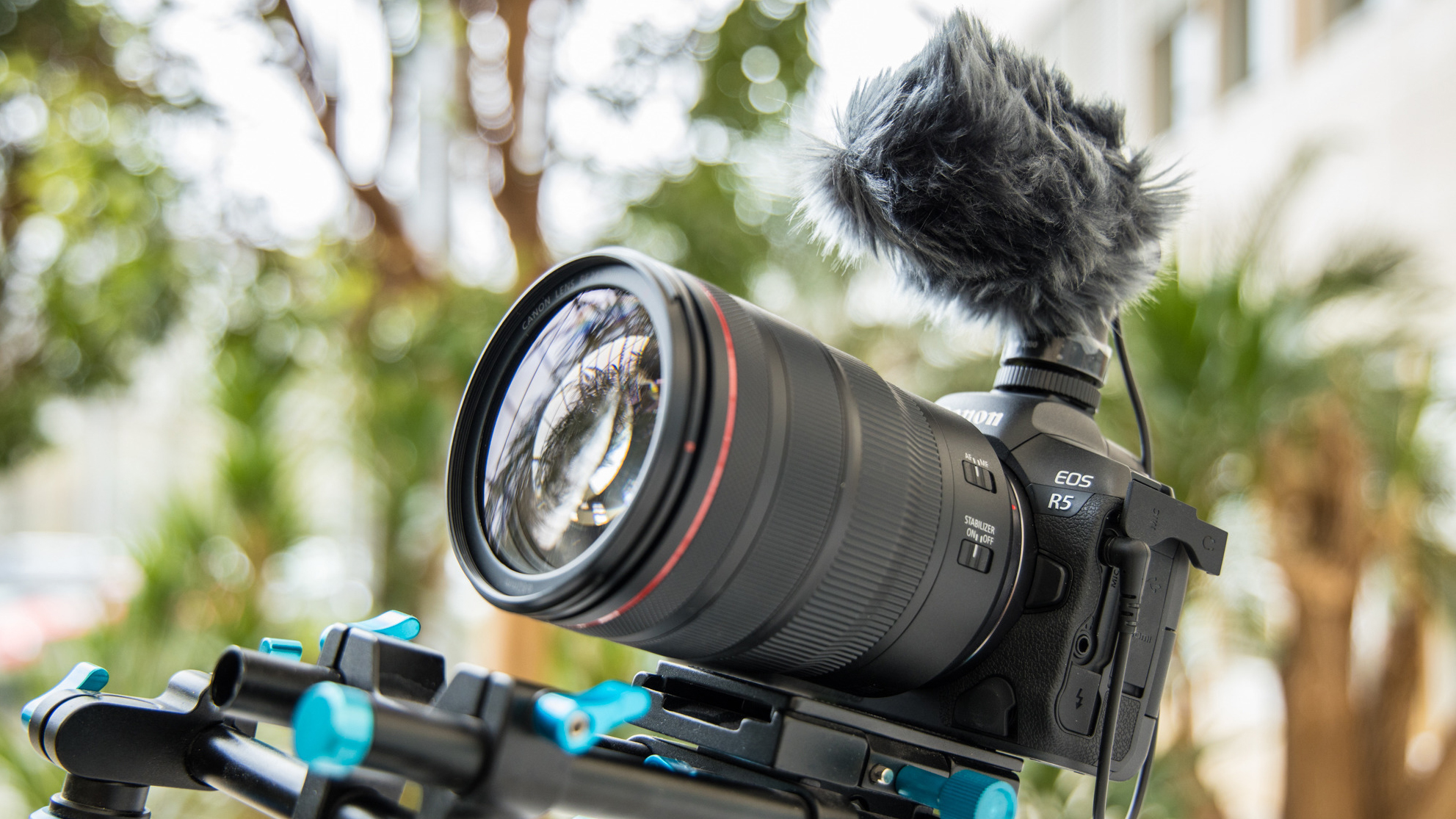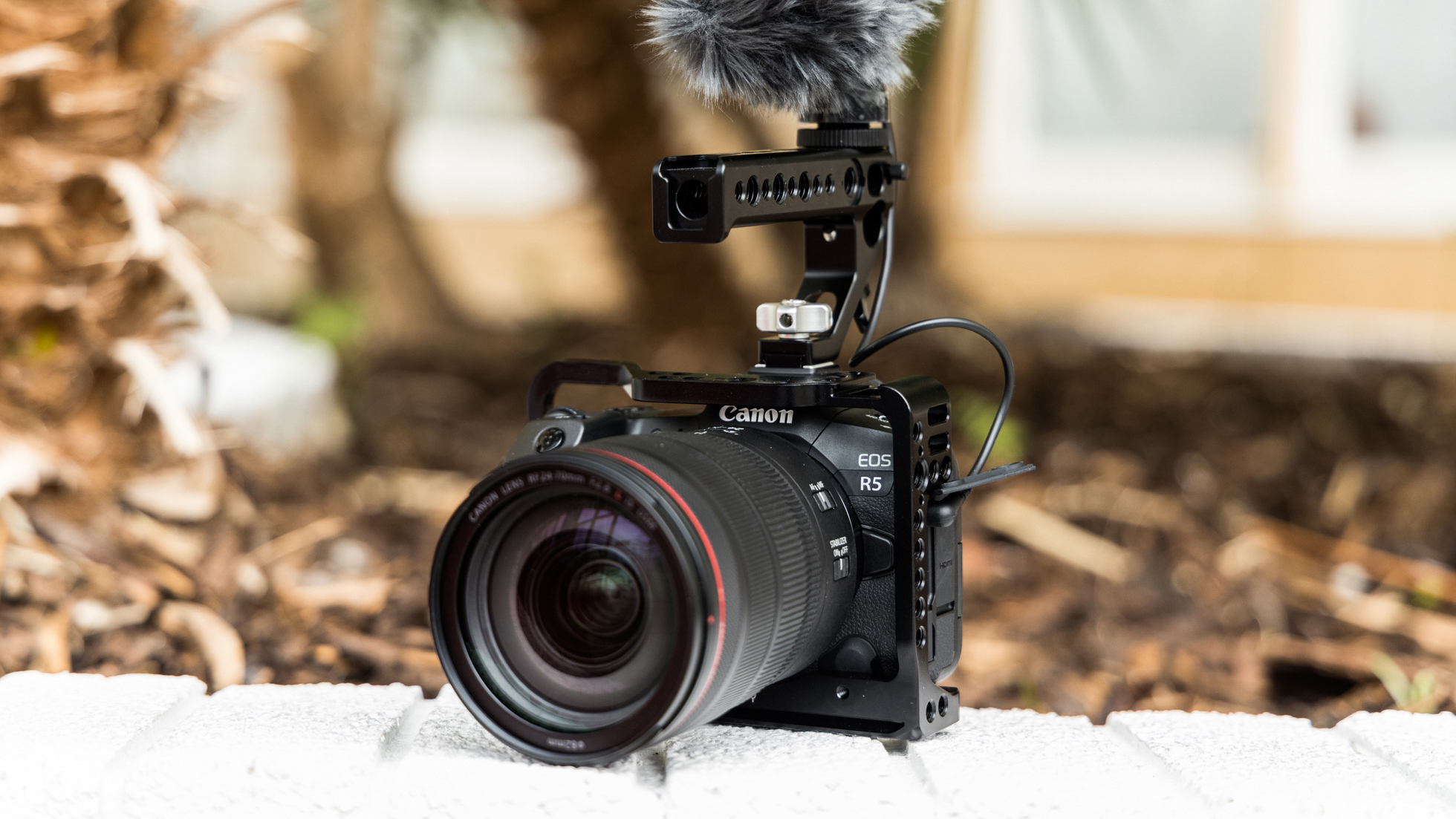Why the Canon EOS R5 could be 'mind blowing' for video, according to a director

The Canon EOS R5’s latest teaser announcement caused quite a stir this week. Not only is this relatively small, full-frame mirrorless camera shaping up to be a powerful stills camera, it appears to have cinema-grade video powers, too.
It’s fair to say we haven’t seen a full-frame camera with this much crossover appeal for some time. But are Canon’s claims that the EOS R5 will “shoot comfortably on high-end production sets” really possible? And how excited should YouTubers and amateur filmmakers be about this camera?
We spoke to an award-winning director to find out. Tim Bunn is Writer/Director at Belafonte and director of short film The Girl Is Mime, starring Martin Freeman. He also has a BFI-backed short coming out in 2020.
Tim mainly shoots with a Canon EOS C200, a camera from the company’s Cinema range that the EOS R5 incredibly trumps in some departments, at least on paper. So it was great to get his thoughts on how exciting this camera really is for video, the potential challenges and opportunities of shooting in 8K, and where the EOS R5 might inevitably fall down compared to dedicated Cinema cameras.
Been eyeing up the Canon EOS R5 as the camera to launch you towards filmmaking glory? Here are a director's thoughts on the specs and features we know about so far...
- Read our Canon EOS R5: release date, news and features round-up

As someone who works on the “high-end productions” that Canon says the EOS R5 is designed for, how impressed are you by its video specs?
“The video specs for the EOS R5 are pretty mind-blowing. There isn’t anything out there right now that currently compares to it, without being a fully-fledged cinema camera,’ director Tim Bunn said.
Sign up for breaking news, reviews, opinion, top tech deals, and more.
“The Blackmagic Pocket Cinema Camera comes to mind, but this ‘only’ records in 6K. 8K captured in RAW in a camera this size offers so many possibilities and will mean the camera has a much broader appeal. Typically, the mirrorless cameras geared towards video will appeal to videographers and small production companies who produce online content. I can see proper feature film productions looking at this camera and thinking ‘we could do something with this’”, he added.
What are your thoughts on shooting in 8K with the EOS R5? Is it just for future-proofing or would it be useful for your shoots today?
“Generally, no one is delivering video or film in 8K; there’s no need to because there’s no realistic way of viewing 8K. That will of course change in time, but for now it does mean that the R5 is well future-proofed,” he said.
“That’s not to say that 8K video doesn’t have its uses. Where 8K is useful for filmmakers is the ability to crop the frame. If I edit an 8K video file in a 4K timeline, I’m only looking at 50% of the total image size. This means I can zoom in by up to another 50% without losing any resolution. This gives me a tighter shot and also gives me a cut (a second camera, if you will) within the edit, which, at times, can be a lifesaver. This was the typical workflow when 4K arrived. Initially, people continued to deliver in 1080p, using the full 4K resolution to give them options within the edit,’ he added.
“But even with this ability to use 8K in this way, I still think that the majority of users are going to shoot in either 4K or 6K – if the latter option is available, I’ll be surprised if it isn’t. Purely because of the space that those 8K files are going to take up and the recording time available at 8K. Both in terms of how much time you’d be able to get out of a decent sized memory card, and whether Canon will limit recording time at 8K to protect the camera’s processor from overheating,” he noted.
“There are also the headaches to consider in dealing with 8K footage in your post-production workflow. It’s a lot of pixels to push around and your computer will struggle to keep up, unless it’s a newly minted Mac Pro,” he added.

Do you think the Canon EOS R5 is an exciting camera for YouTubers and aspiring directors? Would you consider it as your main camera if you were starting out now?
“The first proper short film I shot was on a Canon EOS 5D Mk II, this was the camera that changed the game for digital film and video. It was the first time, if I remember correctly, that you could record video on a full-sized sensor, without having to spend tens, possibly even hundreds of thousands of pounds,” he said.
“Filmmakers could finally create cinematic-looking images without having to be a Hollywood feature film director. It was all about that lovely depth of field. I desperately wanted a 5D Mk II, but even at what was a comparatively affordable price, given what it could do, I still couldn’t afford one,” he added.
“I imagine that the R5 isn’t going to be the cheapest camera in the world, but I’m sure it will still offer exceptional value for money. But this doesn’t mean that everyone will be able to afford one and, typically, filmmakers at the beginning of their journey tend not to be the flushest of fellows. If you’ve got the budget, it looks like you’d be silly not to consider the R5,” he said.
Canon says the EOS R5 will make an “ideal support camera” for pros. How well would it work as a partner for your Canon Cinema cameras and how might it complement them?
“For small production companies like mine, the R5 would be a great support camera. Our main camera is a C200, one of Canon’s Cinema cameras, and on paper, the EOS R5 has the more impressive video specs. But where it won’t be able to keep up is in the practicality area,” he said.
“It’s not going to have full-size XLR connections, built-in ND filters or anything like the same number of programmable buttons. But that’s not to say that the EOS R5 would be relegated to B-Cam for every shoot. There are plenty of run-and-gun situations where the R5 would be more than enough. For most videographers it will need a few accessories to make it truly usable and as I said before, I expect that there will be people rigging this thing up to shoot broadcast ads and even elements of full-on feature films,” he added.
“For me and many others, one of the main draws of Canon cameras is the color science, and it will be interesting to see how the EOS R5 compares to the cinema cameras in this respect. We currently use a C100 as a B-Cam to our C200 – while they work well together, the colour output differs more than I expected it to, and I’ve always put this down to two sensors that are quite different. The R5 is going to present another gear-change in sensor tech, so getting it side-by-side with some of its bigger brothers will be fascinating,” he said.

Lastly, do you have any concerns about some of the video specs Canon hasn’t elaborated on yet?
“The recording limit is always a concern. I expect that recording in 8K will be limited to protect the processor from overheating, but the reality of this doesn’t bother me too much, based on how the full 8K resolution is likely to be used. I expect 4K recording will not have a time limit – if it does, this would be more of a concern,’ he said.
“Although Canon has confirmed Raw recording, I’d like to see how this is implemented. Raw video isn’t actually Raw video, there is always some form of compression, and this is even true of the big cinema cameras like RED and Arri, their Raw data still uses some form of compression. Our C200 offers the ability to shoot in Canon’s Cinema Raw Light, and I’d guess this is what they’ll opt for on the R5,’ he added.
“Again, though, how much the average user will opt to shoot in this format remains to be seen. It adds steps to your post workflow and also means you’re dealing with bigger file sizes and more limitations on your recording time. At the end of the day, if you’re a run-and-gun shooter or a small production company and uploading exclusively to the web, I just don’t think shooting Raw is worth the extra hassle,” he said.
- These are the best cameras you can buy right now

Mark is TechRadar's Senior news editor. Having worked in tech journalism for a ludicrous 17 years, Mark is now attempting to break the world record for the number of camera bags hoarded by one person. He was previously Cameras Editor at both TechRadar and Trusted Reviews, Acting editor on Stuff.tv, as well as Features editor and Reviews editor on Stuff magazine. As a freelancer, he's contributed to titles including The Sunday Times, FourFourTwo and Arena. And in a former life, he also won The Daily Telegraph's Young Sportswriter of the Year. But that was before he discovered the strange joys of getting up at 4am for a photo shoot in London's Square Mile.